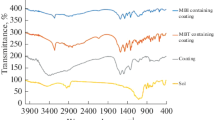Abstract
DBTL as neutral polycondensation catalyst was employed to obtain organic modified silanes (ORMOSILs), which were studied as anticorrosive films for aluminum at saline corrosion. The ORMOSILs were synthesized using TEOS as silica precursor, different alkylalkoxysilanes (trimethoxy(methyl)silane, triethoxy(octyl)silane, 3-aminopropyl(triethoxy)silane and DBTL-catalyst were employed under the free solvent sol–gel process. Results of chemical characterization of ORMOSILs coatings show that under SEM technique coatings have homogenous films, and there are a crosslinking between silica and organic modified under the Infrared spectroscopy and 29Si CPMAS-NMR techniques. On the other hand, Brinell hardness and Pull-Off adhesion tests show that all ORMOSILs increase the aluminum surface hardness between 1 and 10%, and the ORMOSILs critical forces for adhesion are in the range of 106–132 N; therefore, the ORMOSILs coatings have an excellent adhesion to aluminum surface, furthermore, the saline corrosion test shows that organic modified silica avoid the pitting aluminum corrosion; corrosion rate decreases about 60–85%; the anticorrosive behavior according to modified-silica was determined as: SiO2–NH2 > SiO2–Me ∼ SiO2–Octyl.

Highlights
-
DBTL is proposed as poly-condensation catalyst between TEOS and alkylalkoxysilanes for the formation of anticorrosive coating.
-
ORMOSIL increases the hardness of aluminum surface.
-
DBTL forms ceramic hard coating with excellent adhesion.
-
ORMOSIL–DBTL diminishes the corrosion rate at 60–85%.












Similar content being viewed by others
References
Groysman A (2010) Corrosion for everybody. Springer, New York
Sheng J, Xia J (2017) Construction and build. Materials 131:90–100
Speidel MO, Hyatt MV (1972) Stress-corrosion cracking of high-strength aluminum alloys. In: Fontana MG, Staehle RW (eds) Advances in corrosion science and technology, vol 2. Springer, Boston, MA
Gharavi F, Matori KA, Yunus R, Othman NK, Fadaeifard F (2015) J Mater Res Technol 4:314–322
Donatus U, Thompson GE, Omotoyinbo OG, Alaneme KK, Aribo S, Agbabiaka OG (2017) Trans Nonferrous Met Soc China 27:55–62
Zhang X, Zhou X, Ma Y, Thompson GE, Luo C, Sun Z, Zhang X, Tang Z (2016) Surf Interface Anal 48:745–749
Zhang X, Zhou X, Hashimoto T, Liu B (2017) Mater Charact 130:230–236
U.S. Department of Health and Human Services, Public Health Service, Agency for Toxic Substances and Disease Registry, 2008 Toxicological Profile for Chromium. www.atsdr.cdc.gov/toxprofiles/tp7.pdf
Balgude D, Sabins A (2012) J Sol-Gel Sci Technol 64:124–134
Wang D, Bierwagen GP (2009) Prog Org Coat 64:327–338
Figueira RB, Fontinha IR, Silva CJR, Pereira EV (2016) Coatings 6:12
Figueira RB, Silva CJR, Pereira EV (2015) J Coat Technol Res 12:1–35
Zea C, Barranco-García R, Alcántara J, Chico B, Morcillo M, de la Fuente D (2017) J Coat Technol Res 14:869–878
Borisova D, Mohwald H, Shchukin DG (2011) ACS Nano 5:1939–1946
Falcón JM, Otubo LM, Aoki IV (2016) Surf Coat Technol 303:319–329
More AP, Mhaske ST (2016) Arab J Sci Eng 41:2239–2248
Hench LL, West JK (1990) Chem Rev 90:33–72
Ko EI (1999) Sol-gel process. In: Ertl G, Knözinger G, Weitkamp J (eds) Preparation of solid catalysts. Wiley-VCH Verlag GmbH, Weinheim, Germany
Salazar-Hernández C, Zárraga R, Alonso S, Sugita S, Calixto S, Cervantes J (2009) J Sol-Gel Sci Technol 49:301–310
Salazar-Hernández C, Alonso S, Cervantes J (2010) J Sol-Gel Sci Technol 54(1):77–82
Van der Weij F W (1980) Makromol Chem 181:2541–2548
Cervantes J, Zarraga R, Salazar-Hernández C (2012) Appl Organ Chem 26:157–163
Salazar-Hernández C, Salazar-Hernández M, Carrera-Cerritos R, Elorza E, Mendoza-Miranda JM, Navarro R (2017) J Sol-Gel Sci Techonl 81:405–412
Standard guide for preparation of metallographic specimens. Norm ASTM E3-11
Standard test method for brinell hardness of metallic materials. Norm ASTM E10-15a
Standard test method for pull-off strength of coatings using portable adhesion testers. Norm ASTM D4541-17
Launer PJ (1987) Infrared analysis of organosilicon compounds: spectra structure correlation silicon compounds. In: Arkles B (ed) Gelest Inc:Morrisville, PA
Marsmann HC (1999) 29Si NMR in molecular sciences and chemical engineering from encyclopedia of spectroscopy and apectrometry. 2nd edn., vol 17, pp 2539–2549
Kohl JG, Singer IL (1999) Prog Org Coat 36:15–20
Barroso de Aguiar J, Cruz MD (1998) J Adhes Sci Technol 12:1243–1251
Acknowledgement
The authors wish to acknowledge the financial support of the CONACyT through grant CB-186327/2012 register as SIP-2013-Re/099; also to LICAM-LAB of the University of Guanajuato for SEM analysis. Finally, the authors appreciate the technical support of Daniela Mocada in SEM analysis and Luis A. Hernández.
Author information
Authors and Affiliations
Corresponding authors
Ethics declarations
Conflict of interest
The authors declare that they have no conflict of interest.
Rights and permissions
About this article
Cite this article
Salazar-Hernández, C., Salazar-Hernández, M., Mendoza-Miranda, J.M. et al. Organic modified silica obtained from DBTL polycondensation catalyst for anticorrosive coating. J Sol-Gel Sci Technol 87, 299–309 (2018). https://doi.org/10.1007/s10971-018-4732-9
Received:
Accepted:
Published:
Issue Date:
DOI: https://doi.org/10.1007/s10971-018-4732-9




